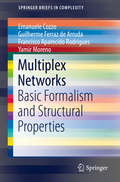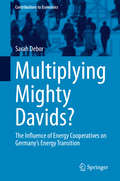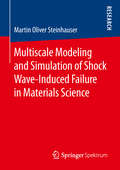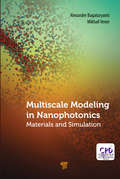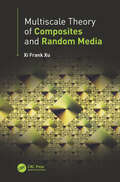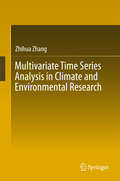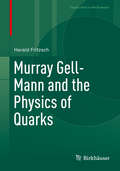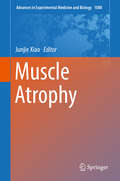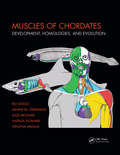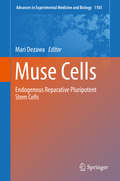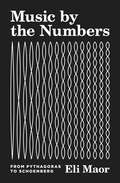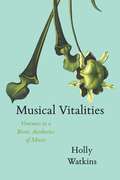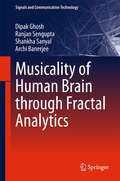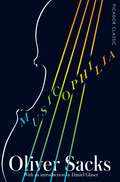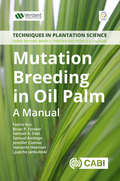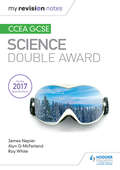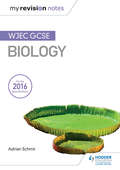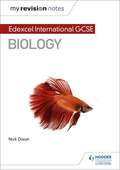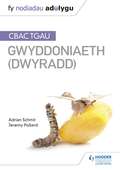- Table View
- List View
Multiplex Networks: Basic Formalism and Structural Properties (SpringerBriefs in Complexity)
by Emanuele Cozzo Guilherme Ferraz de Arruda Francisco Aparecido Rodrigues Yamir MorenoThis book provides the basis of a formal language and explores its possibilities in the characterization of multiplex networks. Armed with the formalism developed, the authors define structural metrics for multiplex networks. A methodology to generalize monoplex structural metrics to multiplex networks is also presented so that the reader will be able to generalize other metrics of interest in a systematic way. Therefore, this book will serve as a guide for the theoretical development of new multiplex metrics. Furthermore, this Brief describes the spectral properties of these networks in relation to concepts from algebraic graph theory and the theory of matrix polynomials. The text is rounded off by analyzing the different structural transitions present in multiplex systems as well as by a brief overview of some representative dynamical processes. Multiplex Networks will appeal to students, researchers, and professionals within the fields of network science, graph theory, and data science.
Multiplying Mighty Davids?: The Influence of Energy Cooperatives on Germany's Energy Transition (Contributions to Economics)
by Sarah DeborThis book systematically describes and evaluates the impact of energy cooperatives as a key driving force in the German energy transition toward a sustainability-oriented energy sector. Based on a comprehensive survey and three case studies, it provides an instructive overview of the overall dimensions and scope of energy cooperatives in Germany, and of their history, structure and current investment projects. The book not only contributes to the energy policy discourse in Germany, but also highlights the role of energy cooperatives to enable an international readership to explore their potential in other countries. Further, it makes a theoretical contribution toward substantially supplementing actor research in general, and enterprise research in particular, in the field of sustainability transitions science.
Multiscale Modeling and Simulation of Shock Wave-Induced Failure in Materials Science
by Martin Oliver SteinhauserMartin Oliver Steinhauser deals with several aspects of multiscale materials modeling and simulation in applied materials research and fundamental science. He covers various multiscale modeling approaches for high-performance ceramics, biological bilayer membranes, semi-flexible polymers, and human cancer cells. He demonstrates that the physics of shock waves, i.e., the investigation of material behavior at high strain rates and of material failure, has grown to become an important interdisciplinary field of research on its own. At the same time, progress in computer hardware and software development has boosted new ideas in multiscale modeling and simulation. Hence, bridging the length and time scales in a theoretical-numerical description of materials has become a prime challenge in science and technology.
Multiscale Modeling in Nanophotonics: Materials and Simulations
by Alexander Bagaturyants Mikhail VenerThe idea of theoretically predicting the useful properties of various materials using multiscale simulations has become popular in recent years. Of special interest are nanostructured, organic functional materials, which have a hierarchical structure and are considered materials of the future because of their flexibility and versatility. Their functional properties are inherited from the molecule that lies at the heart of the hierarchical structure. On the other hand, the properties of this functional molecule, in particular its absorption and emission spectra, strongly depend on its interactions with its molecular environment. Therefore, the multiscale simulations used to predict the properties of organic functional materials should be atomistic, that is, they should be based on classical and/or quantum methods that explicitly take into account the molecular structure and intermolecular interactions at the atomic level. This book, written by well-known specialists in theoretical chemistry, focuses on the basics of classical mechanics, quantum chemistry methods used for molecular disordered materials, classical methods of molecular simulations of disordered materials, vibronic interactions, and applications (presented as multiscale strategies for atomistic simulations of photonic materials). It has been edited by Professor Mikhail Alfimov, a renowned Russian scientist, a full member of the Russian Academy of Sciences, Russia, and the founder, first director, and now research supervisor of the Photochemistry Center of the Russian Academy of Science, Russia. Professor Alfimov’s main research interests are in the field of photochemistry and photophysics of molecular and supramolecular systems. The book is a great reference for advanced undergraduate- and graduate-level students of nanotechnology and molecular science and researchers in nano- and molecular science, nanotechnology, chemistry, and physical chemistry, especially those with an interest in functional materials.
Multiscale Theory of Composites and Random Media
by Xi Frank XuThis is the first book to introduce Green-function-based multiscale theory and the corresponding finite element method, which are readily applicable to composites and random media. The methodology is considered to be the one that most effectively tackles the uncertainty of stress propagation in complex heterogeneities of random media, and which presents multiscale theory from distinctive scale separation and scale-coupling viewpoints. Deliberately taking a multiscale perspective, it covers scale separation and then scale coupling. Both micromechanics and novel scale-coupling mechanics are described in relation to variational principles and bounds, as well as in the emerging topics on percolation and scale-coupling computation. It gives detail on the different bounds encountered, covering classical second and third order, new fourth order, and innovative ellipsoidal variations. Green-function-based multiscale theory is addressed to applications in solid mechanics and transport of complex media ranging from micro- and nano-composites, polycrystals, soils, rocks, cementitious materials, to biological materials. It is useful as a graduate textbook in civil and mechanical engineering and as a reference.
Multiscale Theory of Composites and Random Media
by Xi Frank XuThis is the first book to introduce Green-function-based multiscale theory and the corresponding finite element method, which are readily applicable to composites and random media. The methodology is considered to be the one that most effectively tackles the uncertainty of stress propagation in complex heterogeneities of random media, and which presents multiscale theory from distinctive scale separation and scale-coupling viewpoints. Deliberately taking a multiscale perspective, it covers scale separation and then scale coupling. Both micromechanics and novel scale-coupling mechanics are described in relation to variational principles and bounds, as well as in the emerging topics on percolation and scale-coupling computation. It gives detail on the different bounds encountered, covering classical second and third order, new fourth order, and innovative ellipsoidal variations. Green-function-based multiscale theory is addressed to applications in solid mechanics and transport of complex media ranging from micro- and nano-composites, polycrystals, soils, rocks, cementitious materials, to biological materials. It is useful as a graduate textbook in civil and mechanical engineering and as a reference.
Multivariate Time Series Analysis in Climate and Environmental Research
by Zhihua ZhangThis book offers comprehensive information on the theory, models and algorithms involved in state-of-the-art multivariate time series analysis and highlights several of the latest research advances in climate and environmental science. The main topics addressed include Multivariate Time-Frequency Analysis, Artificial Neural Networks, Stochastic Modeling and Optimization, Spectral Analysis, Global Climate Change, Regional Climate Change, Ecosystem and Carbon Cycle, Paleoclimate, and Strategies for Climate Change Mitigation. The self-contained guide will be of great value to researchers and advanced students from a wide range of disciplines: those from Meteorology, Climatology, Oceanography, the Earth Sciences and Environmental Science will be introduced to various advanced tools for analyzing multivariate data, greatly facilitating their research, while those from Applied Mathematics, Statistics, Physics, and the Computer Sciences will learn how to use these multivariate time series analysis tools to approach climate and environmental topics.
Murray Gell-Mann and the Physics of Quarks (Classic Texts in the Sciences)
by Harald FritzschMurray Gell-Mann, Physics Nobel Prize Laureate in 1969 is known for his theoretical work on elementary particle physics and the introduction of quarks and together with H. Fritzsch the “Quantum Chromodynamics”. Based on four sections the Editor gives an overview on the work of Gell-Mann and his contributions to various aspects of the physics, related to quarks. His most important and influential papers were selected and reprinted so that the reader easily can check the original work of Gell-Mann.
Muscle Atrophy (Advances in Experimental Medicine and Biology #1088)
by Junjie XiaoThe book addresses the development of muscle atrophy, which can be caused by denervation, disuse, excessive fasting, aging, and a variety of diseases including heart failure, chronic kidney diseases and cancers. Muscle atrophy reduces quality of life and increases morbidity and mortality worldwide. The book is divided into five parts, the first of which describes the general aspects of muscle atrophy including its characteristics, related economic and health burdens, and the current clinical therapy. Secondly, basic aspects of muscle atrophy including the composition, structure and function of skeletal muscle, muscle changes in response to atrophy, and experimental models are summarized. Thirdly, the book reviews the molecular mechanisms of muscle atrophy, including protein degradation and synthesis pathways, noncoding RNAs, inflammatory signaling, oxidative stress, mitochondria signaling, etc. Fourthly, it highlights the pathophysiological mechanisms of muscle atrophy in aging and disease. The book’s fifth and final part covers the diagnosis, treatment strategies, promising agents and future prospects of muscle atrophy. The book will appeal to a broad readership including scientists, undergraduate and graduate students in medicine and cell biology.
Muscles of Chordates: Development, Homologies, and Evolution
by Rui Diogo Janine M. Ziermann Julia Molnar Natalia Siomava Virginia AbdalaChordates comprise lampreys, hagfishes, jawed fishes, and tetrapods, plus a variety of more unfamiliar and crucially important non-vertebrate animal lineages, such as lancelets and sea squirts. This will be the first book to synthesize, summarize, and provide high-quality illustrations to show what is known of the configuration, development, homology, and evolution of the muscles of all major extant chordate groups. Muscles as different as those used to open the siphons of sea squirts and for human facial communication will be compared, and their evolutionary links will be explained. Another unique feature of the book is that it covers, illustrates, and provides detailed evolutionary tables for each and every muscle of the head, neck and of all paired and median appendages of extant vertebrates. Key Selling Features: Has more than 200 high-quality anatomical illustrations, including evolutionary trees that summarize the origin and evolution of all major muscle groups of chordates Includes data on the muscles of the head and neck and on the pectoral, pelvic, anal, dorsal, and caudal appendages of all extant vertebrate taxa Examines experimental observations from evolutionary developmental biology studies of chordate muscle development, allowing to evolutionarily link the muscles of vertebrates with those of other chordates Discusses broader developmental and evolutionary issues and their implications for macroevolution, such as the links between phylogeny and ontogeny, homology and serial homology, normal and abnormal development, the evolution, variations, and birth defects of humans, and medicine.
Muscles of Chordates: Development, Homologies, and Evolution
by Rui Diogo Janine M. Ziermann Julia Molnar Natalia Siomava Virginia AbdalaChordates comprise lampreys, hagfishes, jawed fishes, and tetrapods, plus a variety of more unfamiliar and crucially important non-vertebrate animal lineages, such as lancelets and sea squirts. This will be the first book to synthesize, summarize, and provide high-quality illustrations to show what is known of the configuration, development, homology, and evolution of the muscles of all major extant chordate groups. Muscles as different as those used to open the siphons of sea squirts and for human facial communication will be compared, and their evolutionary links will be explained. Another unique feature of the book is that it covers, illustrates, and provides detailed evolutionary tables for each and every muscle of the head, neck and of all paired and median appendages of extant vertebrates. Key Selling Features: Has more than 200 high-quality anatomical illustrations, including evolutionary trees that summarize the origin and evolution of all major muscle groups of chordates Includes data on the muscles of the head and neck and on the pectoral, pelvic, anal, dorsal, and caudal appendages of all extant vertebrate taxa Examines experimental observations from evolutionary developmental biology studies of chordate muscle development, allowing to evolutionarily link the muscles of vertebrates with those of other chordates Discusses broader developmental and evolutionary issues and their implications for macroevolution, such as the links between phylogeny and ontogeny, homology and serial homology, normal and abnormal development, the evolution, variations, and birth defects of humans, and medicine.
Muse Cells: Endogenous Reparative Pluripotent Stem Cells (Advances in Experimental Medicine and Biology #1103)
by Mari DezawaThis book provides the first comprehensive account of multilineage-differentiating stress-enduring (Muse) cells, a pluripotent and non-tumorigenic subpopulation of mesenchymal stem cells (MSCs) that have the ability to detect damage signals, migrate to damaged sites, and spontaneously differentiate into cells compatible with the affected tissue, thereby enabling repair of all tissue types. The coverage encompasses everything from the basic properties of Muse cells to their tissue repair effects and potential clinical applications—for example, in acute myocardial infarction, stroke, skin injuries and ulcers, renal failure, and liver disease. An important technical chapter provides a practical and precise protocol for the isolation of Muse cells, which will enable readers to use Muse cells in their own research. In offering fascinating insights into the strategic organization of the body’s reparative function and explaining how full utilization of Muse cells may significantly enhance the effectiveness of MSC treatment, the book will be of high value for Ph.D. students, postdocs, basic researchers, clinical doctors, and industrial developers.
Music by the Numbers: From Pythagoras to Schoenberg
by Eli MaorHow music has influenced mathematics, physics, and astronomy from ancient Greece to the twentieth centuryMusic is filled with mathematical elements, the works of Bach are often said to possess a math-like logic, and Igor Stravinsky said "musical form is close to mathematics," while Arnold Schoenberg, Iannis Xenakis, and Karlheinz Stockhausen went further, writing music explicitly based on mathematical principles. Yet Eli Maor argues that music has influenced math at least as much as math has influenced music. Starting with Pythagoras, proceeding through the work of Schoenberg, and ending with contemporary string theory, Music by the Numbers tells a fascinating story of composers, scientists, inventors, and eccentrics who played a role in the age-old relationship between music, mathematics, and the sciences, especially physics and astronomy. Music by the Numbers explores key moments in this history, particularly how problems originating in music have inspired mathematicians for centuries. Perhaps the most famous of these problems is the vibrating string, which pitted some of the greatest mathematicians of the eighteenth century against each other in a debate that lasted more than fifty years and that eventually led to the development of post-calculus mathematics. Other highlights in the book include a comparison between meter in music and metric in geometry, complete with examples of rhythmic patterns from Bach to Stravinsky, and an exploration of a suggestive twentieth-century development: the nearly simultaneous emergence of Einstein's theory of relativity and Schoenberg's twelve-tone system.Weaving these compelling historical episodes with Maor's personal reflections as a mathematician and lover of classical music, Music by the Numbers will delight anyone who loves mathematics and music.
Music by the Numbers: From Pythagoras to Schoenberg
by Eli MaorHow music has influenced mathematics, physics, and astronomy from ancient Greece to the twentieth centuryMusic is filled with mathematical elements, the works of Bach are often said to possess a math-like logic, and Igor Stravinsky said "musical form is close to mathematics," while Arnold Schoenberg, Iannis Xenakis, and Karlheinz Stockhausen went further, writing music explicitly based on mathematical principles. Yet Eli Maor argues that music has influenced math at least as much as math has influenced music. Starting with Pythagoras, proceeding through the work of Schoenberg, and ending with contemporary string theory, Music by the Numbers tells a fascinating story of composers, scientists, inventors, and eccentrics who played a role in the age-old relationship between music, mathematics, and the sciences, especially physics and astronomy. Music by the Numbers explores key moments in this history, particularly how problems originating in music have inspired mathematicians for centuries. Perhaps the most famous of these problems is the vibrating string, which pitted some of the greatest mathematicians of the eighteenth century against each other in a debate that lasted more than fifty years and that eventually led to the development of post-calculus mathematics. Other highlights in the book include a comparison between meter in music and metric in geometry, complete with examples of rhythmic patterns from Bach to Stravinsky, and an exploration of a suggestive twentieth-century development: the nearly simultaneous emergence of Einstein's theory of relativity and Schoenberg's twelve-tone system.Weaving these compelling historical episodes with Maor's personal reflections as a mathematician and lover of classical music, Music by the Numbers will delight anyone who loves mathematics and music.
Musical Vitalities: Ventures in a Biotic Aesthetics of Music (New Material Histories of Music)
by Holly WatkinsDoes it make sense to refer to bird song—a complex vocalization, full of repetitive and transformative patterns that are carefully calculated to woo a mate—as art? What about a pack of wolves howling in unison or the cacophony made by an entire rain forest? Redefining music as “the art of possibly animate things,” Musical Vitalities charts a new path for music studies that blends musicological methods with perspectives drawn from the life sciences. In opposition to humanist approaches that insist on a separation between culture and nature—approaches that appear increasingly untenable in an era defined by human-generated climate change—Musical Vitalities treats music as one example of the cultural practices and biotic arts of the animal kingdom rather than as a phenomenon categorically distinct from nonhuman forms of sonic expression. The book challenges the human exceptionalism that has allowed musicologists to overlook music’s structural resemblances to the songs of nonhuman species, the intricacies of music’s physiological impact on listeners, and the many analogues between music’s formal processes and those of the dynamic natural world. Through close readings of Austro-German music and aesthetic writings that suggest wide-ranging analogies between music and nature, Musical Vitalities seeks to both rekindle the critical potential of nineteenth-century music and rejoin the humans at the center of the humanities with the nonhumans whose evolutionary endowments and planetary fates they share.
Musical Vitalities: Ventures in a Biotic Aesthetics of Music (New Material Histories of Music)
by Holly WatkinsDoes it make sense to refer to bird song—a complex vocalization, full of repetitive and transformative patterns that are carefully calculated to woo a mate—as art? What about a pack of wolves howling in unison or the cacophony made by an entire rain forest? Redefining music as “the art of possibly animate things,” Musical Vitalities charts a new path for music studies that blends musicological methods with perspectives drawn from the life sciences. In opposition to humanist approaches that insist on a separation between culture and nature—approaches that appear increasingly untenable in an era defined by human-generated climate change—Musical Vitalities treats music as one example of the cultural practices and biotic arts of the animal kingdom rather than as a phenomenon categorically distinct from nonhuman forms of sonic expression. The book challenges the human exceptionalism that has allowed musicologists to overlook music’s structural resemblances to the songs of nonhuman species, the intricacies of music’s physiological impact on listeners, and the many analogues between music’s formal processes and those of the dynamic natural world. Through close readings of Austro-German music and aesthetic writings that suggest wide-ranging analogies between music and nature, Musical Vitalities seeks to both rekindle the critical potential of nineteenth-century music and rejoin the humans at the center of the humanities with the nonhumans whose evolutionary endowments and planetary fates they share.
Musical Vitalities: Ventures in a Biotic Aesthetics of Music (New Material Histories of Music)
by Holly WatkinsDoes it make sense to refer to bird song—a complex vocalization, full of repetitive and transformative patterns that are carefully calculated to woo a mate—as art? What about a pack of wolves howling in unison or the cacophony made by an entire rain forest? Redefining music as “the art of possibly animate things,” Musical Vitalities charts a new path for music studies that blends musicological methods with perspectives drawn from the life sciences. In opposition to humanist approaches that insist on a separation between culture and nature—approaches that appear increasingly untenable in an era defined by human-generated climate change—Musical Vitalities treats music as one example of the cultural practices and biotic arts of the animal kingdom rather than as a phenomenon categorically distinct from nonhuman forms of sonic expression. The book challenges the human exceptionalism that has allowed musicologists to overlook music’s structural resemblances to the songs of nonhuman species, the intricacies of music’s physiological impact on listeners, and the many analogues between music’s formal processes and those of the dynamic natural world. Through close readings of Austro-German music and aesthetic writings that suggest wide-ranging analogies between music and nature, Musical Vitalities seeks to both rekindle the critical potential of nineteenth-century music and rejoin the humans at the center of the humanities with the nonhumans whose evolutionary endowments and planetary fates they share.
Musical Vitalities: Ventures in a Biotic Aesthetics of Music (New Material Histories of Music)
by Holly WatkinsDoes it make sense to refer to bird song—a complex vocalization, full of repetitive and transformative patterns that are carefully calculated to woo a mate—as art? What about a pack of wolves howling in unison or the cacophony made by an entire rain forest? Redefining music as “the art of possibly animate things,” Musical Vitalities charts a new path for music studies that blends musicological methods with perspectives drawn from the life sciences. In opposition to humanist approaches that insist on a separation between culture and nature—approaches that appear increasingly untenable in an era defined by human-generated climate change—Musical Vitalities treats music as one example of the cultural practices and biotic arts of the animal kingdom rather than as a phenomenon categorically distinct from nonhuman forms of sonic expression. The book challenges the human exceptionalism that has allowed musicologists to overlook music’s structural resemblances to the songs of nonhuman species, the intricacies of music’s physiological impact on listeners, and the many analogues between music’s formal processes and those of the dynamic natural world. Through close readings of Austro-German music and aesthetic writings that suggest wide-ranging analogies between music and nature, Musical Vitalities seeks to both rekindle the critical potential of nineteenth-century music and rejoin the humans at the center of the humanities with the nonhumans whose evolutionary endowments and planetary fates they share.
Musicality of Human Brain through Fractal Analytics (Signals and Communication Technology)
by Dipak Ghosh Ranjan Sengupta Shankha Sanyal Archi BanerjeeThis book provides a comprehensive overview of how fractal analytics can lead to the extraction of interesting features from the complex electroencephalograph (EEG) signals generated by Hindustani classical music. It particularly focuses on how the brain responses to the emotional attributes of Hindustani classical music that have been long been a source of discussion for musicologists and psychologists. Using robust scientific techniques that are capable of looking into the most intricate dynamics of the complex EEG signals, it deciphers the human brain’s response to different ragas of Hindustani classical music, shedding new light on what happens inside the performer’s brain when they are mentally composing the imagery of a particular raga. It also explores the much- debated issue in the musical fraternity of whether there are any universal cues in music that make it identifiable for people throughout the world, and if so, what are the neural correlates associated with the universal cues? This book is of interest to researchers and scholars of music and the brain, nonlinear science, music cognition, music signal processing and music information retrieval. In addition, researchers in the field of nonlinear biomedical signal processing and music signal analysis benefit from this book.
Musicophilia: Tales of Music and the Brain (Picador Classic #72)
by Oliver SacksFrom the bestselling author of Awakenings and The Man Who Mistook His Wife for a Hat.
Mutation Breeding in Oil Palm: A Manual (Techniques in Plantation Science)
by Fazrin Nur Brian Forster Samual A. Osei Samuel Amiteye Jennifer Ciomas Soeranto Hoeman Ljupcho JankuloskiThis is a practical guide to mutation breeding in oil palm, representing completely novel work supported by the Plant Breeding and Genetics Section of the Joint FAO/IAEA Division (Vienna, Austria). Oil palm is the top oil crop and the only major crop and only oil crop not to have been improved by plant mutation breeding. The manual is hands-on, providing step-by-step illustrated methods in mutation induction, mutation detection and mutant line development for oil palm improvement. Presenting sound practices based on scientific innovation and knowledge, this guide provides techniques integrated with expertise and is authored by practitioners actively engaged in oil palm seed production and breeding. Promoting green, eco-friendly agriculture, this book features coverage of: Radio-sensitivity testing Challenges and opportunities for mutation breeding Protocol for developing mutant generations for mutant screening Services in irradiation treatments The only available resource containing protocols and guidelines on how oil palm can be manipulated for mutation breeding, this book is essential reading for oil palm breeders, seed producers and plantation companies, oil palm traders, students and research institutes across the world. It provides a resource for training, a knowledge base for people new to oil palm and a reference guide for managers, to ensure best practices in maximising sustainability and production of this important crop. .
My Revision Notes: CCEA GCSE Double Award Science (PDF)
by Alyn G. McFarland James Napier Roy WhiteTarget success in CCEA GCSE Double Award Science with this proven formula for effective, structured revision; key content coverage is combined with exam-style tasks and practical tips to create a revision guide that students can rely on to review, strengthen and test their knowledge.With My Revision Notes, every student can:- Plan and manage a successful revision programme using the topic-by-topic planner- Consolidate subject knowledge by working through clear and focused content coverage- Test understanding and identify areas for improvement with regular 'Now Test Yourself' tasks and answers- Improve exam technique through practice questions, expert tips and examples of typical mistakes to avoid- Get exam ready with extra quick quizzes and answers to the practice questions available online
My Revision Notes: WJEC GCSE Biology
by Adrian SchmitTarget success in Science with this proven formula for effective, structured revision; key content coverage is combined with exam-style tasks and practical tips to create a revision guide that students can rely on to review, strengthen and test their knowledge.With My Revision Notes, every student can:- Plan and manage a successful revision programme using the topic-by-topic planner- Consolidate subject knowledge by working through clear and focused content coverage- Test understanding and identify areas for improvement with regular 'Now Test Yourself' tasks and answers- Improve exam technique through practice questions, expert tips and examples of typical mistakes to avoid- Get exam ready with extra quick quizzes and answers to the practice questions available online
My Revision Notes: Edexcel International GCSE (MRN)
by Nick DixonTarget success in Edexcel International GCSE Biology with this proven formula for effective, structured revision; key content coverage is combined with exam-style tasks and practical tips to create a revision guide that students can rely on to review, strengthen and test their knowledge. - Plan and manage a successful revision programme using the topic-by-topic planner - Consolidate subject knowledge by working through clear and focused content coverage - Test understanding and identify areas for improvement with regular 'Now Test Yourself' tasks and answers - Improve exam technique through practice questions, expert tips and examples of typical mistakes to avoid - Get exam ready with extra quick quizzes and answers to the practice questions available online
My Revision Notes: Wjec Gcse Science Double Award Welsh Epub
by Adrian Schmit Jeremy PollardTarget success in Science with this proven formula for effective, structured revision; key content coverage is combined with exam-style tasks and practical tips to create a revision guide that students can rely on to review, strengthen and test their knowledge.With My Revision Notes, every student can:- Plan and manage a successful revision programme using the topic-by-topic planner- Consolidate subject knowledge by working through clear and focused content coverage- Test understanding and identify areas for improvement with regular 'Now Test Yourself' tasks and answers- Improve exam technique through practice questions, expert tips and examples of typical mistakes to avoid- Get exam ready with extra quick quizzes and answers to the practice questions available online
